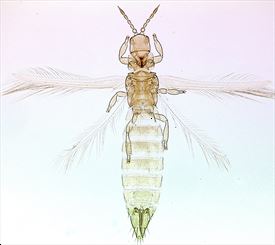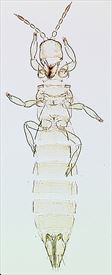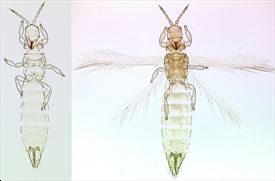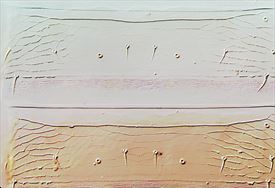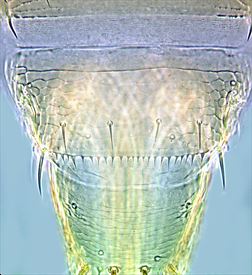Distinguishing features
Both sexes fully winged, females commonly micropterous. Body and legs brownish yellow, brown markings on pronotum, laterally on mesonotum and metascutum, medially on tergites; antennal segment I yellow, II–IV yellowish brown, V–IX darker brown; fore wings pale, veins weakly shaded; tergites IX–X with dark setae. Head longer than wide, produced in front of eyes; eyes with 6 pigmented facets; ocellar setae III outside ocellar triangle, anterior to hind ocelli; head with sculpture behind eyes, but not near ocelli. Antennae 9-segmented, III & IV each with sense cone forked, VI–VII broadly joined by oblique suture; VI with pedicel. Pronotum weakly sculptured medially; with no long setae. Metascutum reticulate, median setae well behind anterior margin; campaniform sensilla present. Fore wing first vein with about 7 setae near base, 3–4 widely spaced setae on distal half; second vein with about 9 setae, with no setae basal to vein fork; clavus with 5–6 veinal setae and one seta at base. Abdominal tergites with small dentate microtrichia on sculpture lines laterally; II–VII with sculpture medially (rarely very weak), small dentate microtrichia on posterior margin laterally; VIII with postero-marginal comb complete; spiracles occupying no more than 0.3 of lateral margin of tergite VIII. Female microptera similar but wing shorter than thorax width.
Male similar to female but known only from Iran; tergite IX with 2 pairs of stout setae medially; sternites with C-shaped pore plates varying in size.
Related species
Out of a total of 81 species of Anaphothrips worldwide, 43 are known from Australia (Mound & Masumoto, 2009) and five from New Zealand. Many of these species have the antennae clearly 9-segmented, others clearly have only 8 segments, but several species are similar to A. obscurus in having an intermediate condition with segment VI bearing a partial and often oblique transverse suture. The abdominal tergites of females usually bear distinct reticulate markings medially although these can be difficult to see on some pale specimens.
Biological data
Feeding and breeding on the leaves of grasses (Poaceae), commonly in leaf axils, this species is sometimes considered a minor pest on various cereal crops, including Avena, Hordeum, Secale, Triticum and Zea.
Distribution data
Widespread in New Zealand, and worldwide in temperate areas.
Family name
THRIPIDAE, THRIPINAE
Species name
Anaphothrips obscurus (Muller)
Original name and synonyms
Thrips obscura Muller, 1776: 96
Limothrips poaphagus Comstock, 1875: 120
Thrips striata Osborn, 1883, 155
Anaphothrips virgo Uzel, 1895: 148
Anaphothrips obscurus f. collaris Priesner, 1926: 185
Anaphothrips obscurus f. grisea Priesner, 1926: 185
Anaphothrips 6-guttus Girault, 1928: 1
Anaphothrips discrepans Bagnall, 1933: 651.
References
Mirab-balou M & Chen XX (2010) First description of the male of the wheat thrips, Anaphothrips obscurus (Thysanoptera: Thripidae). Zootaxa, 2540: 65–68.
Mound LA & Masumoto M (2009) Australian Thripinae of the Anaphothrips genus-group (Thysanoptera), with three new genera and thirty-three new species. Zootaxa 2042: 1–76.
Mound LA & Walker AK (1982) Terebrantia (Insecta: Thysanoptera). Fauna of New Zealand 1: 1–113.

